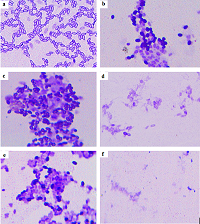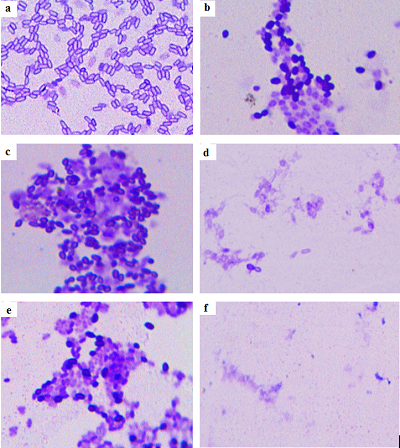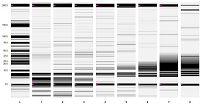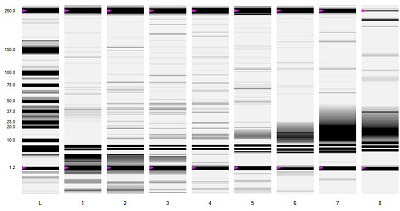Development of a method for the extraction of the total proteome of bacillus anthracis spores
1Stavropol Research Anti-Plague Institute, 13-15, Sovetskaya str., Stavropol, 355035 Russia
2North Caucasus Federal University, Stavropol, 355009 Russia;*e-mail: postgenom_stv@mail.ru
Keywords:Bacillus anthracis; spore proteome; extraction of the proteomic complex; lysis solutions; disintegration; 2D-gel electrophoresis
DOI:10.18097/BMCRM00154
We have developed a method for obtaining the total proteome of Bacillus anthracis spores, which combines efficient protein extraction with reliable disinfection of samples. We used 7 strains of B. anthracis: 4 plasmid-free, 3 diplasmid, one of which with an atypical type of capsule formation in air. The schemes for isolating the total spore proteome were tested using various lysis solutions in the presence of bacterial protease inhibitors, with the inclusion of the stages of treatment of spores with trichloroacetic acid and mechanical disintegration and with their exclusion. The quality and completeness of the extraction of the total proteome of the spores of the samples was assessed in one-dimensional (1D) and two- dimensional (2D) electrophoresis. Treatment of spores with trichloroacetic acid increased the reliability of material disinfection and reduces the loss of the final product. Mechanical disintegration after treatment of spores with lysing solutions increases the completeness of extraction of spore proteins in a wide range of molecular weights and facilitated the process of sterilizing filtration. Final filtration of the lysate through a PVDF filter with a pore size of 0.22 µm provided additional decontamination of samples without reducing their quality. Thus, the use of the proposed sample preparation scheme makes it possible to obtain complete protein extracts of spores of B. anthracis strains, suitable for comparative analysis of the proteome and search for a possible correlation with the features phenotypic properties and mechanisms that ensure the preservation of the pathogen anthrax in environmental objects, including soil
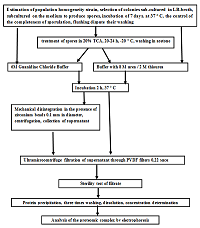
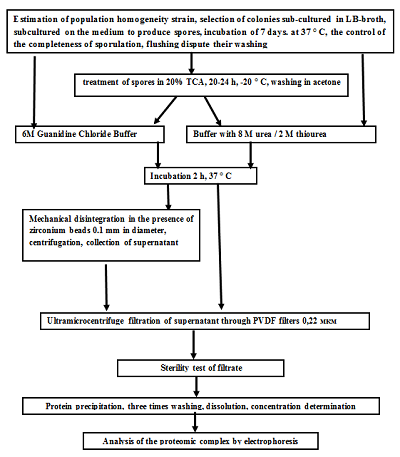
|
Figure 1.
Research scheme for the development of an extraction algorithm for the proteomic complex of B. anthracis spores.
|

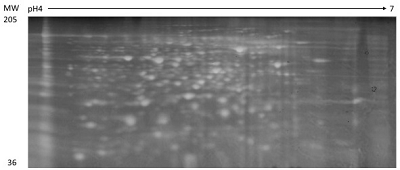
|
Figure 4.
2D electrophoretogram of the total spore proteome extracts of the B. anthracis 1 (CO) -23 strain, zinc staining. Strip pH 4-7.
|
|
CLOSE

|
Table 1.
Lysis buffers used for total proteome extraction from B. anthracis spore suspension.
|
FUNDING
The study was carried out on the topic of research work as part of the implementation of the Rospotrebnadzor Sectoral Research Program for the period 2021-2025. “Scientifc support of epidemiological surveillance and sanitary protection of the territory of the Russian Federation. Creation of new technologies, means and methods of control and prevention of infectious and parasitic diseases”.
REFERENCES
- Schuch, R., & Fischetti, V.A. (2009) The secret life of the anthrax agent Bacillus anthracis: bacteriophage-mediated ecological adaptations. PloS one, 4(8), e6532. DOI
- Stewart, G.C. (2015) The Exosporium Layer of Bacterial Spores: a Connection to the Environment and the Infected Host. Microbiology and molecular biology reviews : MMBR, 79(4), 437–457. DOI
- Chenau, J., Fenaille, F., Caro, V., Haustant, M., Diancourt, L., Klee, S.R., Junot, C., Ezan, E., Goossens, P.L., Becher, F. (2014) Identification and validation of specific markers of Bacillus anthracis spores by proteomics and genomics approaches. Molecular & cellular proteomics : MCP, 13(3), 716–732. DOI
- Chen, Y., Barat, B., Ray, W.K., Helm, R.F., Melville, S.B., & Popham, D.L. (2019) Membrane Proteomes and Ion Transporters in Bacillus anthracis and Bacillus subtilis Dormant and Germinating Spores. Journal of bacteriology, 201(6), e00662-18. DOI
- Driks A. (2009) The Bacillus anthracis spore. Molecular aspects of medicine, 30(6), 368–373. DOI
- Koteneva, E.A. ,Tsygankova, O.I., Kalinin, A.V., Rodionov, I.S., Abramovich A.V., Shcherbakova, V.Yu. (2019) Features of obtaining the protein complex of vegetative cultures Bacillus anthracis for proteomic mapping of strains. Journal of microbiology, epidemiology and immunobiology, 4: 311–338. DOI
- Lasch, P., Nattermann, H., Erhard, M., Stämmler, M., Grunow, R., Bannert, N., Appel, B., Naumann, D. (2008) MALDI-TOF mass spectrometry compatible inactivation method for highly pathogenic microbial cells and spores. Analytical chemistry, 80(6), 2026–2034. DOI
- Lai, E. M., Phadke, N.D., Kachman, M.T., Giorno, R., Vazquez, S., Vazquez, J.A., Maddock, J.R., Driks, A. (2003) Proteomic analysis of the spore coats of Bacillus subtilis and Bacillus anthracis. Journal of bacteriology, 185(4), 1443–1454. DOI
- Bauer, T., Little, S., Stöver, A.G., & Driks, A. (1999) Functional regions of the Bacillus subtilis spore coat morphogenetic protein CotE. Journal of bacteriology, 181(22), 7043–7051. DOI
- Steichen, C., Chen, P., Kearney, J.F., Turnbough, C.L., Jr (2003) Identification of the immunodominant protein and other proteins of the Bacillus anthracis exosporium. Journal of bacteriology, 185(6), 1903–1910. DOI
- Redmond, C., Baillie, L., Hibbs, S., Moir, A., Moir, A. (2004) Identification of proteins in the exosporium of Bacillus anthracis. Microbiology (Reading, England), 150(Pt 2), 355–363. DOI
- Deatherage Kaiser, B. L., Wunschel, D. S., Sydor, M. A., Warner, M. G., Wahl, K. L., & Hutchison, J. R. (2015). Improved proteomic analysis following trichloroacetic acid extraction of Bacillus anthracis spore proteins. Journal of microbiological methods, 118, 18–24. DOI
- Sydor, M.A., Warner, M.G., Wahl, K.L., Hutchison, J.R. (2015) Improved proteomic analysis following trichloroacetic acid extraction of Bacillus anthracis spore proteins. Journal of microbiological methods, 118, 18–24. DOI
- Shibata, H., Murakami, H., Tani, I. (1980). Delayed germination of Bacillus cereus T spores after treatment with trichloroacetic acid and their reactivation by heating. Microbiology and immunology, 24(4), 291–298. DOI
- Report on the Potential Exposure to Anthrax Centers for Disease Control and Prevention (2014) https://www.cdc.gov/labs/pdf/Final_Anthrax_Report.pdf
